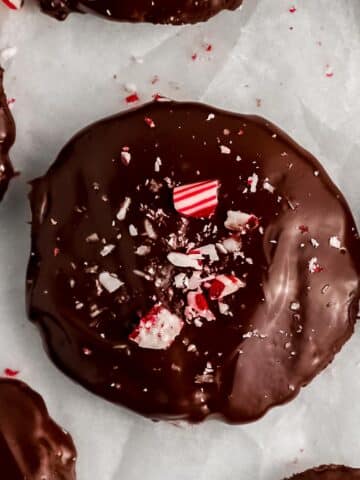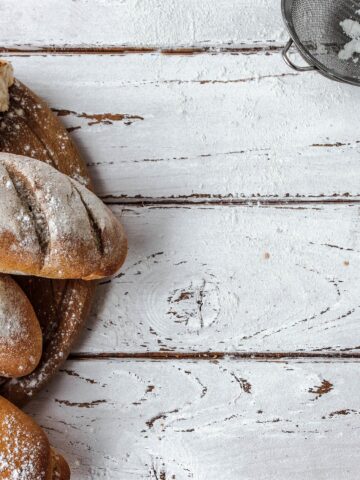Xanthan gum is an effective binder in gluten-free baking and gives baked goods that fluffy texture, but it is possible to successfully bake WITHOUT xanthan gum. Continue reading to learn my tips for making gluten-free baked goods without xanthan gum.
Gluten is found naturally in wheat, barley, rye, and oats. While celiac disease (a condition where the immune system attacks the lining of the intestine) affects around 0.5% of Americans, other autoimmune diseases such as Hashimoto’s thyroiditis affect millions more. These conditions require strict adherence to a gluten-free diet.
Some recipes call for xanthan gum in gluten-free baking. It's a thickener made from fermented cornstarch. Xanthan gum can be found in most gluten-free flour blends available today, but there are a few brands that don't contain any. Xanthan gum can trigger allergic reactions in some people, so if you're avoiding that ingredient, you may find yourself stuck when trying to make most gluten-free recipes.
Jump to:
- 1. Substitute Gluten-Free Flour Mixes
- 2. Use Xanthan Gum Alternatives
- 3. Add More Liquid (a cup of water)
- 4. Experiment With Different Baking Methods
- Innovative Solutions for Gluten-Free Baking Without Xanthan Gum
- Expert Tips for Gluten-Free Baking Without Xanthan Gum
- FAQ Section
- The Future of Gluten-Free Baking
- Closing Thoughts
- You'll be amazed by these easy recipes for baked goods made without xanthan gum!
1. Substitute Gluten-Free Flour Mixes
Many gluten-free flour mixes contain dry ingredients like xanthan gum, along with other ingredients like tapioca starches, guar gum, and brown rice flour. But, there are a few gluten-free flour blends that don't require xanthan gum. For example, King Arthur makes a gluten-free all-purpose flour mix that does not contain xanthan gum and can be used interchangeably with regular all-purpose flour.
2. Use Xanthan Gum Alternatives
Xanthan gum is used in gluten-free baking because it creates a fluffy texture. There are alternatives to xanthan gum like guar gum, agar, locust bean gum, konjac root powder, and tara gum. My favorite replacement for xanthan gum is psyllium husk, a natural fiber that comes from the seeds of the plant Plantago ovata. When psyllium husk is soaked in water, it becomes a gel. The gel can keep muffins, bread, cookies, and cakes soft and moist.
3. Add More Liquid (a cup of water)
Adding more liquid to your recipe can compensate for the lack of thickeners. For example, adding ½ cup of water or milk to a cake batter can replace the function of xanthan gum. More liquid is always necessary in gf recipes to prevent a dry texture. To read more about why gluten-free baked goods can be dry, read my blog on the science of gluten-free baking.
4. Experiment With Different Baking Methods
Baking methods also change the consistency of dough. Baking bread in a hot oven rather than a cold oven results in a denser loaf. Oven temperature is essential in gluten-free recipes, so I recommend an external oven thermometer and reading up on why oven temperature matters HERE.
Innovative Solutions for Gluten-Free Baking Without Xanthan Gum
Navigating the world of gluten-free baking without xanthan gum can be a rewarding journey with the right ingredients and brands at your disposal. Below, we explore various baking endeavors, offering specific product recommendations to help you achieve the best results.
Perfecting Gluten-Free Scones Without Xanthan Gum
For those seeking to bake light and airy scones, turning to brands that offer xanthan gum-free flour blends is a great start. Caputo Gluten Free Flour is an excellent choice, as it's formulated specifically for baking without the need for xanthan gum. When making scones, incorporating Anthony's Organic Flaxseed Meal as a binding agent can ensure your scones hold together beautifully while adding a nutritional boost.
Crafting Gluten-Free Pasta from Scratch
Creating gluten-free pasta without xanthan gum is entirely possible with the right flour. Caputo Gluten Free provides a fantastic base for pasta dough, offering the elasticity and texture needed without additional gums. To enhance the dough's binding properties, adding an egg or Organic Psyllium Husk Powder can make your pasta dough pliable and ready for shaping into your favorite pasta forms.
Choosing Flour Blends for All Baking Needs
When it comes to all-purpose baking, King Arthur Gluten-Free Measure for Measure Flour stands out for its versatility and ease of use, requiring no additional xanthan gum. This blend works wonderfully for a variety of baked goods, from fluffy pancakes to decadent cakes, ensuring successful gluten-free baking endeavors every time.
Morning Delight: Gluten-Free Pancakes
For a delightful breakfast, try making pancakes using this Gluten-Free Baking and Pancake Mix. This mix is designed for those avoiding xanthan gum and yields light and fluffy pancakes. Enhance your pancakes with Enjoy Life Semi-Sweet Chocolate Mini Chips for a touch of sweetness without dairy or soy, making your morning treat even more special.
Exploring Xanthan Gum Alternatives
Diving into the world of xanthan gum alternatives can open up new possibilities in gluten-free baking. Guar Gum is an excellent choice for recipes requiring a thickener or stabilizer, acting as a perfect substitute for xanthan gum. For bread and pizza dough, Whole Husk Psyllium offers the fiber and gel-forming properties needed for the perfect texture.
Embracing Whole Food Binders
Whole food alternatives not only serve as excellent binders in gluten-free baking but also boost the nutritional profile of your baked goods. Consider incorporating pureed fruits like bananas or applesauce, which add moisture and act as natural binders. These ingredients not only replace the need for xanthan gum but also infuse your recipes with additional flavors and vitamins.
The Role of Aquafaba
Aquafaba, the liquid from cooked chickpeas, is a miraculous ingredient in the world of gluten-free baking. Its ability to mimic the properties of egg whites makes it an invaluable asset for creating fluffy and light textures in cakes, meringues, and even bread. A few tablespoons of aquafaba can dramatically improve the structure of gluten-free baked goods without any gums.
Expert Tips for Gluten-Free Baking Without Xanthan Gum
Temperature Matters: Gluten-free flours often require a specific temperature to achieve the right consistency. Use a kitchen thermometer to ensure your ingredients are at the optimal temperature for mixing and baking.
Rest Your Dough: Allowing your gluten-free dough or batter to rest before baking can significantly improve the texture of the final product. This resting period gives the flours and any gums or binders you're using time to hydrate fully, leading to better consistency and rise in your baked goods.
FAQ Section
While baking powder cannot directly replace xanthan gum's binding properties, it can help add lift to gluten-free baked goods. Consider combining baking powder with a binder like psyllium husk for the best results.
No single substitute works for every recipe. Factors like the desired texture, the recipe's moisture content, and other ingredients will dictate the best alternative. Experimentation is key to finding the perfect blend for each recipe.
Gluten-free flours lack the gluten proteins that give traditional baked goods their structure. Without xanthan gum or another binder, your baked goods might not hold together as well. Using alternatives like flaxseed meal or chia seeds soaked in water can help create a gel-like substance that mimics gluten's structural properties.
The Future of Gluten-Free Baking
As gluten-free baking continues to evolve, so do the techniques and ingredients available to those seeking to avoid gluten. Innovations in flour blends, natural binders, and baking methods open up a world of possibilities for delicious, satisfying gluten-free treats that everyone can enjoy, regardless of dietary restrictions.
Closing Thoughts
Gluten-free baking without xanthan gum is not only possible but can also be a doorway to healthier and more innovative baking practices. By exploring natural binders, adjusting liquid ratios, and employing specific baking techniques, you can create gluten-free baked goods that are just as satisfying as their traditional counterparts. Remember, the key to successful gluten-free baking lies in experimentation and patience, leading to delicious outcomes that cater to all tastes and dietary needs.









Leave a Reply